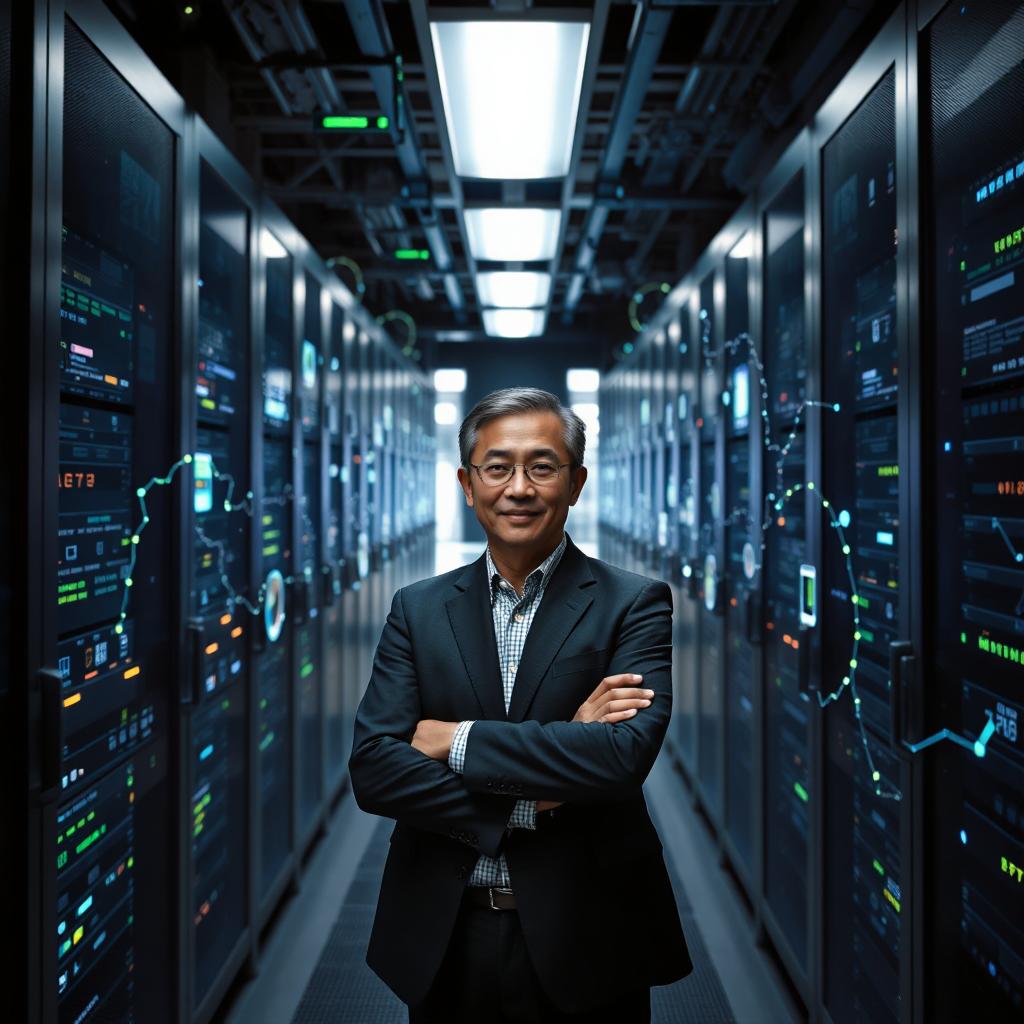⏲️ Estimated reading time: 6 min
📝 Jensen Huang, CEO of NVIDIA, has quietly become one of the most influential figures in tech. His company’s GPUs and AI platforms power nearly every major breakthrough in artificial intelligence. Here’s how he built the modern AI infrastructure.
Jensen Huang: The Man Who Built the AI Infrastructure
Artificial Intelligence (AI) has moved from science fiction into daily life. We see it in voice assistants, image generators, chatbots, autonomous vehicles, and medical diagnostics. But few people know the name Jensen Huang the man whose work made much of this possible.
As the co-founder and CEO of NVIDIA, Huang transformed his company from a gaming graphics card manufacturer into the beating heart of the AI revolution. This post explores how Huang and NVIDIA built the infrastructure that powers the world’s most advanced AI systems.
1. From Gaming to AI: The Origin Story of NVIDIA
Founded in 1993, NVIDIA originally focused on graphics processing units (GPUs) for gaming. Their hardware dominated the PC gaming market, enabling rich, high-performance visuals that gamers loved. Jensen Huang, with his engineering background and visionary mindset, always had ambitions beyond entertainment.
In the early 2000s, Huang recognized a unique advantage in GPUs: their parallel processing capabilities. While CPUs handle tasks sequentially, GPUs can handle thousands of tasks simultaneously ideal for rendering graphics and, as it turned out, training neural networks.
This insight led Huang to bet NVIDIA’s future on accelerating computing and eventually, AI.

2. CUDA: The Software Breakthrough That Changed Everything
In 2006, NVIDIA released CUDA (Compute Unified Device Architecture), a programming platform that allowed developers to use GPUs for general-purpose computing.
This was a game-changer.
Before CUDA, leveraging GPU power for anything outside of graphics was difficult and niche. CUDA made GPU programming accessible, unlocking vast computational power for researchers. Suddenly, complex mathematical models, simulations, and eventually, deep learning algorithms could run faster and at lower costs.
CUDA became the foundation for AI research tools like TensorFlow, PyTorch, and others most of which are GPU-accelerated today.
3. The Deep Learning Boom and NVIDIA’s AI Domination
The AI explosion of the 2010s was powered by deep learning and deep learning needs powerful hardware.
NVIDIA’s Tesla K80, V100, and A100 GPUs became the gold standard for training machine learning models. These GPUs are found in AI research labs, data centers, universities, and government agencies worldwide.
Major AI milestones including GPT-2, GPT-3, and GPT-4 were trained on NVIDIA hardware. OpenAI, Google DeepMind, Meta AI, and Amazon all use NVIDIA GPUs to build their generative models and intelligent agents.
Without NVIDIA, large-scale AI models would take months or even years to train.
4. Jensen Huang’s Vision: More Than Chips
Jensen Huang isn’t just a hardware guy. His strategy has always involved a full-stack approach:
- Chips (Hardware): Powerful, scalable GPUs and AI chips like the H100.
- Software Platforms: CUDA, cuDNN, TensorRT.
- Developer Ecosystem: Over 3 million developers now build on NVIDIA.
- Vertical AI Platforms: Clara for healthcare, Drive for autonomous vehicles, Isaac for robotics, and Omniverse for simulations and digital twins.
This ecosystem strategy ensures NVIDIA stays relevant not only to researchers, but also to developers, startups, corporations, and entire industries.
5. The Rise of the AI Data Center
As demand for training ever-larger AI models grew, so did the need for powerful infrastructure. NVIDIA responded by launching DGX systems AI supercomputers designed specifically for machine learning and deep learning.
- DGX A100: A powerhouse system that can train multiple AI models simultaneously.
- Selene: NVIDIA’s internal supercomputer, among the most powerful AI systems in the world.
- Grace Hopper Superchip: Integrates CPU and GPU for unprecedented AI workloads.
Today, these systems are used by Meta, OpenAI, Tesla, and the U.S. government for applications ranging from vision-language models to self-driving cars.
6. Enabling Generative AI: ChatGPT, Midjourney, and Beyond
The models behind tools like ChatGPT, Midjourney, DALL·E, and RunwayML all depend on NVIDIA hardware.
These models require immense compute power trillions of parameters, billions of training data points, and weeks of fine-tuning. Only a GPU infrastructure like NVIDIA’s can handle this.
Jensen Huang’s company not only provided the tools but also drove the AI boom by:
- Working closely with OpenAI and other labs
- Accelerating transformer model development
- Creating inference optimization tools like TensorRT
7. Strategic Partnerships and Industry Domination
NVIDIA’s reach isn’t just technical it’s strategic.
Jensen Huang struck deals and collaborations with cloud providers (AWS, Google Cloud, Azure), startups, and governments. NVIDIA GPUs are now embedded in cloud infrastructure, supercomputers, autonomous vehicles, medical imaging machines, and smartphones.
Every AI startup pitching investors in 2025 will likely use NVIDIA hardware. Every lab building the next foundation model will use CUDA libraries.
8. The Omniverse and the Future of Simulation
One of NVIDIA’s boldest ventures is the NVIDIA Omniverse a platform to simulate real-world systems in a shared 3D environment.
Jensen believes the Omniverse will become the foundation of digital twins, smart factories, autonomous training environments, and even AI agents who live and learn in virtual spaces.
The Omniverse combines:
- Real-time physics
- Ray tracing
- AI acceleration
It’s already being used by BMW, Lockheed Martin, and Amazon Robotics.
9. Jensen Huang’s Leadership Style and Legacy
Huang is not your average CEO. He’s an engineer at heart, known for wearing his signature leather jacket and delivering electrifying keynote speeches.
He runs NVIDIA like a mission-driven company, always focused on the future. Colleagues and analysts describe him as meticulous, intensely focused, and deeply committed to innovation.
His long-term thinking sometimes criticized in the early days has paid off massively. Today, NVIDIA is one of the world’s most valuable companies, and Jensen Huang is seen as one of the most important leaders in tech.
10. What’s Next for NVIDIA and AI?
As AI evolves, so does NVIDIA’s roadmap. Future focus areas include:
- AI at the Edge: Jetson Nano and Orin chips for robotics and IoT
- AI+5G: Enabling smart cities and connected environments
- Healthcare AI: Accelerating drug discovery and diagnostics
- AI Ethics and Energy Efficiency: Green AI initiatives
Jensen Huang has said that AI is the most powerful technology force of our lifetime. NVIDIA aims to keep pushing its boundaries.
🔍 Perspective: Why Jensen Huang Matters
When you talk about the AI revolution, names like Sam Altman, Demis Hassabis, and Elon Musk come up. But none of them could build what they’re building without Jensen Huang’s infrastructure.
Huang is the unsung hero of artificial intelligence a builder, a visionary, and an enabler of human-machine advancement. His work empowers the minds that train the models, the researchers that publish the papers, and the developers that build the tools you use every day.
He didn’t invent AI but he made it possible.
🔔For more tutorials like this, consider subscribing to our blog.
📩 Do you have questions or suggestions? Leave a comment or contact us!
🏷️ Tags: Jensen Huang, NVIDIA, Artificial Intelligence, GPUs, CUDA, Generative AI, DGX Supercomputer, AI Revolution, Omniverse, Deep Learning
📢 Hashtags: #JensenHuang, #NVIDIA, #AIRevolution, #CUDA, #DeepLearning, #GPUs, #ChatGPT, #OpenAI, #Omniverse, #TechLeadership
Only logged-in users can submit reports.
Discover more from HelpZone
Subscribe to get the latest posts sent to your email.

